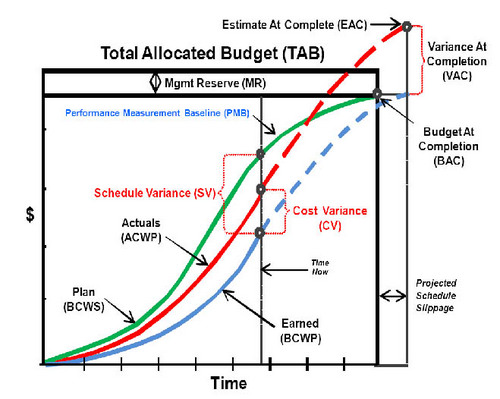ANSI/EIA - 748 - A compliant EVM
ANSI/EIA 748 compliant EVM systems guide
This intent guide was created by the National Defense Industrial Association (NDIA) Program Management Systems Committee (PMSC) to provide additional insight into the earned value management system (EVMS) guidelines included in Section 2 of the ANSI/EIA-748-A Standard for Earned Value Management Systems.
This guide is intended for use by either the government or contractor communities whenever the use of the ANSI/EIA 748 standard is required. It is recommended for use in performing an initial compliance assessment and to perform implementation surveillance.
The primary purpose of this document is to define in detail the management value and intent for each of the guidelines listed in Section 2 of the ANSI/EIA 748 standard. Each intent guideline is numbered for reference purposes.
Accompanying the management value and intent definitions is a list of typical attributes and a list of objective evidence typical outputs that can be used to verify compliance with a given guideline.
Section 2 in this intent document describes the typical attributes and objective evidence that can be used to demonstrate ANSI/EIA 748 EVMS Guidelines compliance.
A contractor who needs to demonstrate that their system complies with the standard can use this intent document to develop a compliance map documenting how their business processes conform to the ANSI/EIA EVMS Guidelines.
The objective of the compliance map is to demonstrate that a contractor has thought through each guideline and can describe how their business process complies with the guideline. Section 3 in this document provides an example of a process description compliance map and Appendix A provides a compliance map template that can be used to help a company develop their own compliance map.
Likewise, a customer or independent reviewer can use the intent, typical attributes, and objective evidence typical outputs described in this document as the basis for verifying compliance to the guidelines.
To use this intent guide as the basis for a compliance assessment or for verifying a business process and system documentation complies with the ANSI/EIA 748 EVMS Guidelines, the NDIA PMSC recommends that:
1. Contractor business processes and system documentation be mapped and verified against the guideline intent, typical attributes, and objective evidence typical outputs described in this document by the process owner. See Section 3 for an example.
2. The compliance assessment is verified by a party independent from the documenting party.
3. The verifying party is versed in the ANSI/EIA 748 EVMS Guidelines.
4. The customer must recognize this method as applicable for the compliance assessment verification to have meaning.
5. Customers should consider past acceptance of compliance to the ANSI/EIA 748 EVMS Guidelines, business organization application policy, and surveillance activity in making a management decision to perform a compliance assessment.
For on-going verification of continued compliance with the ANSI/EIA 748 EVMS Guidelines, the NDIA PMSC Surveillance Guide can be used in combination with this intent guide for this purpose.
To be most effective, compliant business process and system documentation should be implemented on an organization basis instead of program by program. This can be accomplished through EVMS scalability.
EVMS scalability is viewed as a spectrum employing the principles of earned value management as fundamental to all programs and the EVMS Guidelines (ANSI/EIA 748 Section 2) as applicable to large complex and/or high risk programs allowing all programs regardless of size and complexity to realize the benefits of earned value management.
For definitions of common terms used in this intent guide, see Section 2.6 in the ANSI/EIA 748 standard document.
The NDIA PMSC will review and assess the need for revisions to this guide every two years.
Get a copy of the guide at the following internet link:
https://app.box.com/s/qjzltlgwc8uoemtjrf9v
